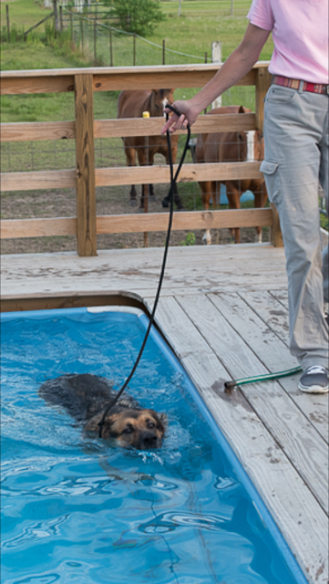
Dog Aquatic Therapy
Why is swimming such a great exercise for rehabilitation and conditioning work? Is it worth the extra effort and money? I believe it is. The resistance of water makes a body work harder to move through it when compared to moving the same distance through the air, i.e. walking or trotting over land. You earn a greater increase (for the time spent) in muscle strength and tone without the impact on the body that running gives you. The important thing to understand about impact is that it is actually waves of force moving up each limb as it strikes the ground. The force wave impacts joints, bone, tendons… everything. An animal that is out of shape or recovering from an injury or extended time off, needs to be gradually brought back to fitness.
As an example, my five-year-old Schutzhund sport dog was extremely fit, muscular, and well-conditioned thirty days ago. After emergency abdominal surgery and illness, there were two weeks of leash-only minimal walking, then two weeks of light activity – more walking and trotting as he desired (without going overboard), but making sure that he did not do any racing around. This week we will start him into very gradual conditioning work. If I just started throwing the ball and letting him race after it, coming to sliding stops and spinning around, he could easily suffer an injury. Just four weeks of inactivity is enough to lose some degree of muscle and bone strength.
If I swim him five or six times a week for two weeks, he will build muscle tone and strength, increase circulation, joint mobility, and improve his cardiovascular fitness; all without the concussion on his bones and joints, and without the risk of injury associated with exercising an unfit body at speed on hard ground. Once the muscle tone has improved enough to be more stabilizing to the joints, which lessens the risk of injury, and his tendons and ligaments have returned to pre-layoff conditions, we will be more confident in running on land to increase the strength and density of bone. In another week or two, we will be confident in adding training exercises that require speed on the ground. It is also summer in the South, which makes it difficult to condition any of us with the heat and humidity. The dog pool is perfect for this!
A dog that has had an orthopedic repair faces the same issues in addition to the very important need to avoid concussive stress on the newly repaired bone. Obese pets also benefit from aquatic therapy. It burns a lot of calories, increases the metabolic rate, and is easy on bones and joints. Obese dogs have a difficult time losing weight because they tire so easily and the bones and joints are not strong enough to carry their extra weight long enough to cause weight loss. The buoyancy of water allows the exercise without requiring the limbs to support the excess weight.
If you think aquatic therapy might be helpful to your pet, give us at K9 Strong a call. It is guaranteed to make him stronger!

Recent Comments